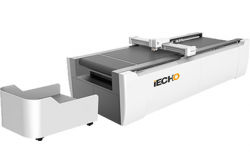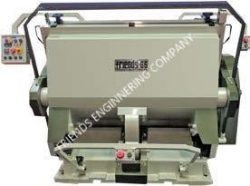What Is a Die Cutting Machine?
The term die cutter is used for a press or machine that cuts the material into a specific shape. From large industrial cutters for furniture to small hand-rollers for cutting office supplies or cute paper cut-outs, die-cutting machines come in a wide variety.
A die cutter cuts with both sharpness and precision – plus it requires almost no skill. All you have to do is put the material into the machine and press it. Another advantage is that it saves a lot of time – once the machine is set up, even the complex shapes needed to make gift boxes can be cut in seconds.
Portable cutters do not require a computer or network connection, whereas other cutters do, and like printers, they take their input from a PC and offer more functionality. Their cutters are also more customizable and detailed and can cut any shape. Some of them also offer functions such as cutting and printing, creasing, and embossing.
BK2 High-Speed Digital Cutting System
Basic principles
Die-cutting is actually a very simple process. Think of cutting biscuit dough – as you apply pressure from above, the blade of the biscuit cutter tears through the dough and cuts it. In the case of using a die cutter, a hydraulic press pushes the sharp blade down into the material with just enough pressure to cut the material, but not the paper underneath. The exact mechanism varies depending on the type of cut required, the intended material, the precision, and the complexity.
Rotary Die Cutters
These die cutting machines have a cylindrical die that is mounted on a heavy-duty anvil base called a rotary press. A sheet of paper or any other material to be used is fed into the machine. As the sheet moves through the cutter, the die moves with the sheet to cut the shape. Rotating dies can be used with any type of cutter and give much more accurate results than click cutters.
Application of BK2 High-Speed Digital Cutting System
Laser Cutters
Laser cutting machines are used where accuracy is critical, for example, to cut machine parts or very complex designs. The user/operator generates the design using CAD. A highly focused beam of light is used to cut the material into the exact shape of the design. For domestic use, CO2 lasers are usually used, while for industrial applications neodymium or neodymium-yttrium-aluminum-garnet lasers can also be used. The beam is created in the cutter itself by stimulating the laser material with a lamp or electrical discharge. Its power is increased using a mirror and the high power beam is then focused onto the area to be cut using a fiber optic or mirror.
Waterjet die cutters
These, like laser cutting machines, use CAD to guide the water stream through the material. The material is cut due to the pressure of the water flowing at twice the speed of sound. It is often used in industrial processes where accuracy is important and the material can be damaged by the high temperature of the laser. It is also known as cold cutting and can be used for materials ranging from textiles to various metals.
Flatbed cutting machines
In these cutters, the cutting is done on a flat plate. The sheet of material remains stationary and the cutting head falls on it in an up-and-down motion.
The source is from here.








